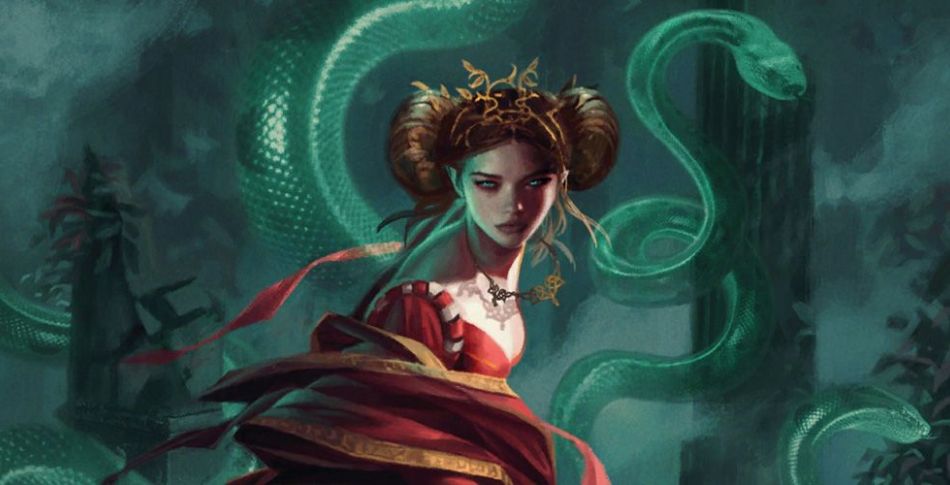

Deck Guide: Francesca Dwarves
This deck guide has been updated for Patch 3.1.
Deck Overview
This is a fresh take on the classic Filavandrel Dwarves deck. The Dwarf archetype is extremely strong in a long round but has a lot of cards that are duds in a short round. Previously, the weakness of the Filavandrel Dwarf deck was being bled in Round 2 and then losing a short Round 3 even with card advantage. However, the introduction of the dual-faction cards Novigradian Justice and Cleaver's Muscle now gives us the option of using Francesca Findabair as the leader for the Dwarves archetype, which significantly helps our short-round capabilities while simultaneously bolstering our long-round ceiling as well.
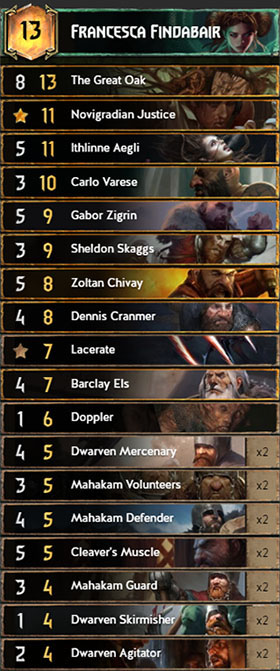
Decklist Breakdown
Novigradian Justice has three viable targets in this deck:
- Dwarven Mercenary as a damage-dealing engine,
- Mahakam Defender as a sticky proactive engine, and
- Cleaver's Muscle as a safe value play.
Justice is a very flexible card: Generally it has a floor of 10 proactive points and it can be much more if our opponent doesn’t have the right answers. We’ll generally be using our leader to replay Justice and we are including Lacerate as a backup option in case we never draw Justice. In a few matchups (like Swarm for example), Lacerate might actually be the better choice. Some players tend to stack their Ranged row against Scoia’tael in order to play around Dwarven Skirmisher, and that plays right into our Lacerate.
Pretty much every single Dwarf card has been thrown into this deck, except for the few super-niche ones like Yarpen Zigrin and Xavier Moran. The majority of the Dwarves are better in longer rounds and not as good in shorter rounds.
Since we are playing Dwarves, we naturally include ST’s signature carryover package of Dwarven Agitator, Sheldon Skaggs, Gabor Zigrin, and Ithlinne Aegli. Ideally, we want to set up our carryover in Round 1 (minus Gabor, which we prefer to play in Round 2), but we also don’t want these low-tempo plays to result in us losing the first round on even cards when we have to go first. Therefore, we include Doppler in the deck to help us get a big-tempo play for a relatively cheap 6-provision card.
The Great Oak is one of ST’s best high-provision cards. It has good synergy with the deck, since we naturally want to rowstack for Dennis Cranmer and Mahakam Guard. We also can fill a row up quite quickly, even in a short round, Novigradian Justice, our leader, and Mahakam Volunteers.
General Gameplan
This deck is usually favored in a long Round 3, so we don’t mind losing Round 1. Most of the time, we actually prefer to lose Round 1, as long as we’re getting out with one card advantage.
Round 1
In Round 1, we set up carryover and thin out Mahakam Volunteers if possible. When going first, we may have to commit a high-tempo play like Doppler or Carlo Varese to compensate for our low-tempo Dwarven Agitator play.
If we don’t have to worry about losing on even, we can play our bad bronzes until we get to 7 cards in hand. We generally want to pass in Round 1 when we have 7 cards, so that we have the maximum hand size at the start of Round 2. This benefits our deck in multiple ways:
- It helps us get the most value out of our Dopplers.
- It gives us more turns to play carryover cards such as Gabor and any handbuffers we might end up drawing into in Round 2.
- If our opponent tries to bleed us in Round 2, we will have an easier time defending a long round since a lot of our dwarves are better in longer rounds. This makes it less likely for us to get 2-0'ed and more likely for us to get ahead in points and keep card advantage for Round 3.
Round 2
At the start of Round 2, we try to get a feel for if the opponent is planning on bleeding or not. Most of the time, we should be able to tell based on the first card they play in Round 2. If they seem uninterested in bleeding, we just play more carryover and thin with Mahakam Volunteers if we haven’t yet. Another big benefit of losing Round 1 is playing Gabor Zigrin in Round 2 uncontested after our opponent passes. If we had won Round 1, our opponent would always have a chance to answer our Gabor in Round 2. Gabor represents at least 5 points of carryover and usually a lot more than that because it is also an engine and a Dwarf body, so it is a huge deal if it sticks.
If the opponent seems like they want to bleed deep in Round 2, we will have to commit long-round engines like Mahakam Defender, Dwarven Mercenary, and potentially even Novigradian Justice on one of those engines. We usually do not want to use our leader in Round 2 unless we are being threatened with a 2-0. There is one exception to this: If we have not drawn Justice yet (which means we might never get a chance to use our leader for it), then we can consider using our leader for Lacerate in Round 2, if that will make a difference in card advantage for Round 3. As Round 2 dwindles down and Round 3 starts looking shorter and shorter, we play out cards like Mahakam Guard, Zoltan Chivay, and Barclay Els, as they would be weak in a short Round 3.
Round 3
If we do get to a long Round 3, we should be favored. Now, our most important decision is what to use Novigradian Justice on. This depends heavily on the matchup and it helps to be knowledgeable about our opponent’s deck and the meta. If our opponent is playing an engine deck and/or a deck with few or no immediate removal options, then Dwarven Mercenary is the best target. If our opponent can easily remove our 3-power Mercenaries, then Mahakam Defender is a better option. We can potentially activate four Defenders at the same time by placing them on the Ranged row and then boosting the row with Dennis Cranmer. If our opponent damages a Defender to turn it off, we can re-boost it with Barclay Els. If we believe our opponent has tall punish and we want to play around it, or if we don’t have any way to activate Defenders, then we can go with the safe play and Justice out Cleaver's Muscle for a respectable 10-point play with two Shields.
It often helps to have an idea of which unit we want to Justice as early as possible (sometimes even before the Round 1 mulligan), because we will try to not play that unit from hand and mulligan it back into the deck. For example, if we realize that Defenders and Mercenaries are not good against a certain removal-heavy matchup, then we should make sure to keep Cleaver's Muscle in the deck for Justice.
Potential Tech Cards
Keep in mind that the Dwarf tag is worth a lot in this list due to synergies with Doppler, Dwarven Mercenary, Barclay Els, Zoltan Chivay, Gabor Zigrin, and Mahakam Guard. The Dwarf tag is worth around 3 points on average, so we should definitely take that into consideration when thinking about replacing a Dwarf with a non-Dwarf or vice-versa.
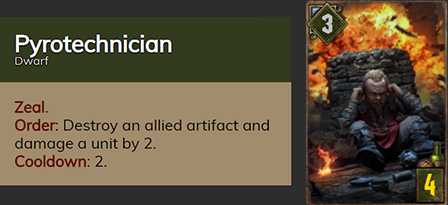 Pyrotechnician is a card we don’t actually want to play, but it is the last remaining 4-provision Dwarf that isn’t currently in our deck. We can consider downgrading other cards to Pyrotechnician if we need provisions elsewhere. It would basically be mulligan fodder, but in general, it should be slightly better than Vrihedd Dragoon or any other non-Dwarf 4-provision card.
Pyrotechnician is a card we don’t actually want to play, but it is the last remaining 4-provision Dwarf that isn’t currently in our deck. We can consider downgrading other cards to Pyrotechnician if we need provisions elsewhere. It would basically be mulligan fodder, but in general, it should be slightly better than Vrihedd Dragoon or any other non-Dwarf 4-provision card.
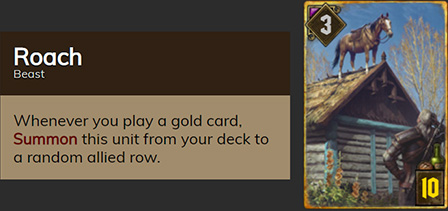 Roach can help us with tempo in Round 1 when we go first and sometimes in Round 2 when we go second. Roach is additional thinning, which is both good and bad. It increases our chances to draw key cards like Justice, but also makes it more likely that we will have to play an extra bad card because we will have one fewer good card in the deck. Roach is also another mulligan liability, which the deck has already in Volunteers and Justice targets.
Roach can help us with tempo in Round 1 when we go first and sometimes in Round 2 when we go second. Roach is additional thinning, which is both good and bad. It increases our chances to draw key cards like Justice, but also makes it more likely that we will have to play an extra bad card because we will have one fewer good card in the deck. Roach is also another mulligan liability, which the deck has already in Volunteers and Justice targets.
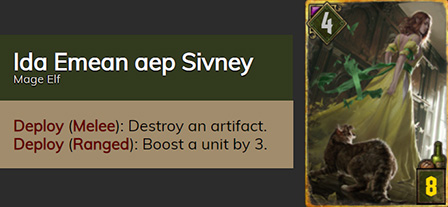 Ida Emean aep Sivney is an artifact removal that also provides an extra boost to reactivate our Defenders. It will almost definitely replace a Dwarf card, which makes Ida significantly less appealing, but might be worth it if the meta is very artifact-heavy.
Ida Emean aep Sivney is an artifact removal that also provides an extra boost to reactivate our Defenders. It will almost definitely replace a Dwarf card, which makes Ida significantly less appealing, but might be worth it if the meta is very artifact-heavy.
 Milva is not really considered, as it’s just a more expensive, low-tempo version of Doppler that can be removed via untargeted damage. Doppler’s relative weakness to tall removal is not a big deal in this deck, since Gabor and Defenders, and sometimes Sheldon Skaggs, play into that anyways.
Milva is not really considered, as it’s just a more expensive, low-tempo version of Doppler that can be removed via untargeted damage. Doppler’s relative weakness to tall removal is not a big deal in this deck, since Gabor and Defenders, and sometimes Sheldon Skaggs, play into that anyways.
Video Deck Guide
Card images from The Voice of Gwent. Editing: Lothari & SwanDive; Website: SwanDive; PR: Callonetta.

Author
Shinmiri2
Shinmiri2 has been playing Gwent since Closed Beta and consistently finished in the Top 100 of Pro Rank. He is known for his educational streaming style as well as being an official caster and analyst for Gwent Masters tournaments. His favourite thing about Gwent is how you can almost always pinpoint the reason or misplay that caused you to win or lose a game, which is vital to improving. He has loved playing competitive strategy games all his life. Before Gwent he was a top-tier Dota player and has competed on teams such as Meet Your Makers and compLexity.






